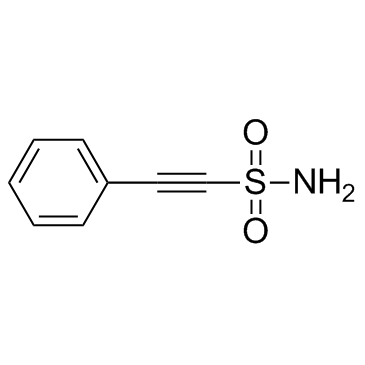2-苯基乙炔磺酰胺

2-苯基乙炔磺酰胺结构式

|
常用名 | 2-苯基乙炔磺酰胺 | 英文名 | Pifithrin-µ |
|---|---|---|---|---|
| CAS号 | 64984-31-2 | 分子量 | 181.212 | |
| 密度 | 1.4±0.1 g/cm3 | 沸点 | 351.7±25.0 °C at 760 mmHg | |
| 分子式 | C8H7NO2S | 熔点 | 135.0 to 139.0 °C | |
| MSDS | 中文版 美版 | 闪点 | 166.5±23.2 °C | |
| 符号 |

GHS07 |
信号词 | Warning |
|
Cell death induced by 2-phenylethynesulfonamide uncovers a pro-survival function of BAX.
Cancer Lett. 354(1) , 115-21, (2014) PES (2-phenylethynesulfonamide) was initially identified as an inhibitor of p53 translocation to mitochondria and named Pifithrin-µ. Further studies showed that PES selectively killed tumour cells and was thus a promising anticancer agent. PES-induced cell de... |
|
|
A Tetrahymena Hsp90 co-chaperone promotes siRNA loading by ATP-dependent and ATP-independent mechanisms.
EMBO J. 34(4) , 559-77, (2015) The loading of small interfering RNAs (siRNAs) and microRNAs into Argonaute proteins is enhanced by Hsp90 and ATP in diverse eukaryotes. However, whether this loading also occurs independently of Hsp90 and ATP remains unclear. We show that the Tetrahymena Hsp... |
|
|
Cross-Presentation of the Oncofetal Tumor Antigen 5T4 from Irradiated Prostate Cancer Cells--A Key Role for Heat-Shock Protein 70 and Receptor CD91.
Cancer. Immunol. Res. 3 , 678-88, (2015) Immune responses contribute to the success of radiotherapy of solid tumors; however, the mechanism of triggering CD8(+) T-cell responses is poorly understood. Antigen cross-presentation from tumor cells by dendritic cells (DC) is a likely dominant mechanism t... |
|
|
Solanesol protects human hepatic L02 cells from ethanol-induced oxidative injury via upregulation of HO-1 and Hsp70.
Toxicol. In Vitro 29(3) , 600-8, (2015) In present study, we showed that the mRNA and protein levels of HO-1 and Hsp70 in solanesol-treated L02 cells were significantly increased. The induction of the HO-1 by solanesol is majorly achieved via enhancing the nuclear translocation and transactivity of... |
|
|
Protein Kinase Cα (PKCα) Is Resistant to Long Term Desensitization/Down-regulation by Prolonged Diacylglycerol Stimulation.
J. Biol. Chem. 291 , 6331-46, (2016) Sustained activation of PKCα is required for long term physiological responses, such as growth arrest and differentiation. However, studies with pharmacological agonists (e.g. phorbol 12-myristate 13-acetate (PMA)) indicate that prolonged stimulation leads to... |
|
|
Structural basis for the inhibition of HSP70 and DnaK chaperones by small-molecule targeting of a C-terminal allosteric pocket.
ACS Chem. Biol. 9(11) , 2508-16, (2014) The stress-inducible mammalian heat shock protein 70 (HSP70) and its bacterial orthologue DnaK are highly conserved nucleotide binding molecular chaperones. They represent critical regulators of cellular proteostasis, especially during conditions of enhanced ... |
|
|
A small molecule inhibitor of inducible heat shock protein 70.
Mol. Cancer Res. 9(7) , 936-47, (2011) The multifunctional, stress-inducible molecular chaperone HSP70 has important roles in aiding protein folding and maintaining protein homeostasis. HSP70 expression is elevated in many cancers, contributing to tumor cell survival and resistance to therapy. We ... |
|
|
HSP70 and HSP90 Differentially Regulate Translocation of Extracellular Antigen to the Cytosol for Cross-Presentation.
Autoimmune Dis 2012 , 745962, (2012) Antigens (Ag) from cancer or virus-infected cells must be internalized by dendritic cells (DCs) to be presented to CD8(+) T cells, which eventually differentiate into Ag-specific cytotoxic T lymphocytes (CTLs) that destroy cancer cells and infected cells. Thi... |
|
|
Antileukemic activity of the HSP70 inhibitor pifithrin-μ in acute leukemia.
Blood Cancer J. 1 , e28, (2012) Heat shock protein (HSP) 70 is aberrantly expressed in different malignancies and has emerged as a promising new target for anticancer therapy. Here, we analyzed the in vitro antileukemic effects of pifithrin-μ (PFT-μ), an inhibitor of inducible HSP70, in acu... |
|
|
Novel Insights into the Interplay between Apoptosis and Autophagy.
Int. J. Cell Biol. 2012 , 317645, (2012) For several decades, apoptosis has taken center stage as the principal mechanism of programmed cell death (type I cell death) in mammalian tissues. Autophagic cell death (type II) is characterized by the massive accumulation of autophagic vacuoles in the cyto... |